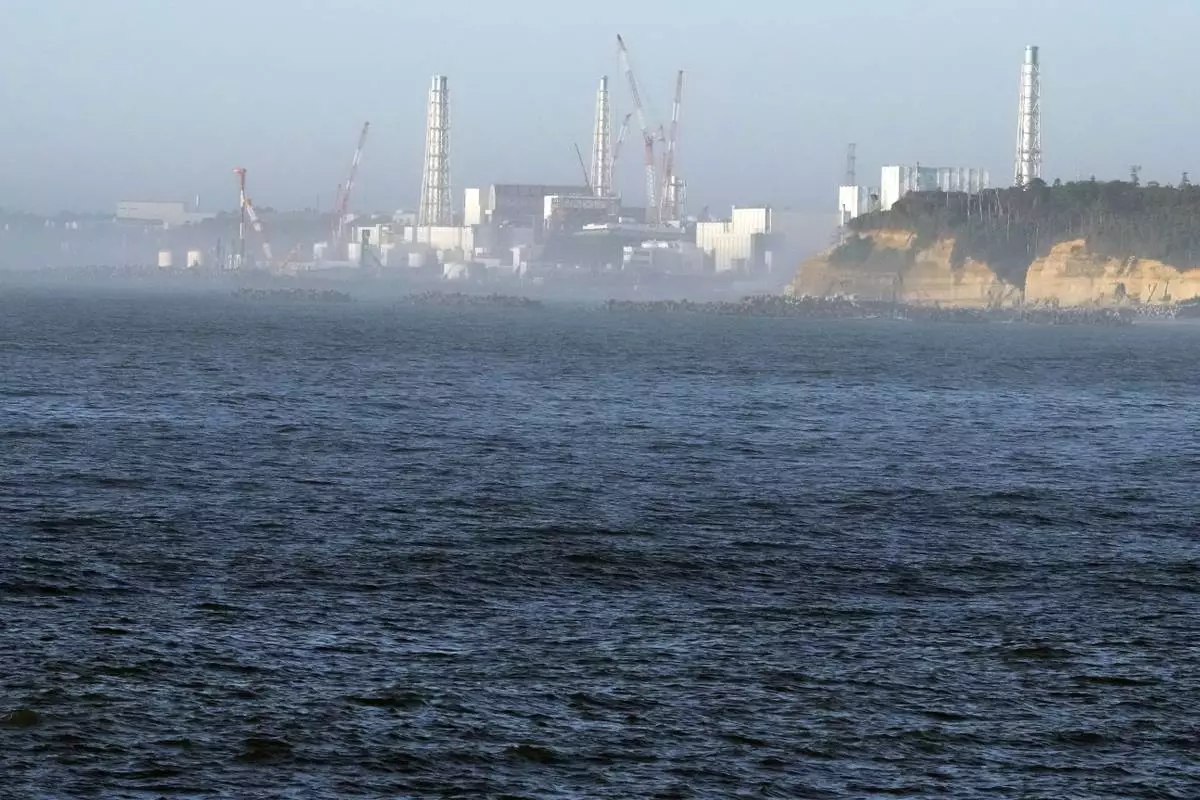TOKYO (AP) — A government-commissioned panel of experts on Wednesday largely supported Japan's new energy policy for the next few years that calls for bolstering renewables up to half of electricity needs by 2040 while maximizing the use of nuclear power as the country seeks to accommodate the growing power demand in the era of AI while meeting decarbonization targets.
The Industry Ministry presented the draft plan for final review by the panel of 16 mostly pro-nuclear members from business, academia and civil groups. It calls for maximizing the use of nuclear energy, reversing a phaseout policy adopted after the meltdown crisis at the Fukushima Daiichi power plant in 2011 that led to extensive displacement of residents and lingering anti-nuclear sentiment.
The plan is due to receive Cabinet approval by March after a period of consultation and will then replace the current energy policy, which dates from 2021. The new proposal says nuclear energy should account for 20% of Japan’s energy supply in 2040, up from just 8.5% last year, while expanding renewables to 40-50% from 22.9% and reducing coal-fired power to 30-40% from nearly 70% last year.
The current plan set a 20-22% target for nuclear energy, 36-38% for renewables and 41% for fossil fuel, for 2030.
Demand for low-carbon energy, such as renewables and nuclear, is growing because of the demand from data centers using AI and semiconductor factories around the country.
Industry Minister Yoji Muto, who attended Wednesday’s panel meeting, said Japan must strengthen its energy security by not relying too much on a single source.
“How we can secure decarbonized energy determines Japan’s future growth,” Muto said. “It's time to stop discussing a choice between renewable energy and nuclear power. We should maximize the use of both renewables and nuclear.”
Japan has set a goal of achieving net zero emissions of climate-warming gases by 2050, and a 73% reduction by 2040 compared to 2013 levels.
The draft energy plan places renewables as the main power source and calls for development of next-generation energy source, such as solar batteries and portable solar panels.
It outlines a number of risk scenarios, including a possibility of less-than-expected investment and cost reduction in renewables. However, some experts said the plan lacked a feasibility outlook for 2040 or a roadmap for the phaseout of fossil fuels.
The plan also calls for acceleration of the restarts of reactors that meet the post-Fukushima safety standards, and proposes construction of next-generation reactors -- at plants where existing reactors are being decommissioned.
Still, to achieve the 20% target, all 33 workable reactors in Japan must be back online, with only 14 back in service after the Fukushima disaster. Given the current pace of safety checks by the nuclear regulation authority, experts say meeting the target would be difficult.
Despite criticisms and skepticism about its feasibility, Japan still sticks to its pursuit of developing advanced reactors and a struggling spent fuel reprocessing program to achieve a complete nuclear fuel cycle.

FILE - The Fukushima Daiichi nuclear power plant, damaged by a massive March 11, 2011, earthquake and tsunami, is seen from the nearby Ukedo fishing port in Namie town, northeastern Japan, Thursday, Aug. 24, 2023. (AP Photo/Eugene Hoshiko, File)
MOGADISHU, Somalia (AP) — Idil Abdullahi Goley’s journey seeking a better life in Europe started in Somalia with a $6,500 payment to local smugglers. It ended a month later with fellow migrants around her dying at sea, one of them screaming and reciting the Muslim profession of faith.
The deaths of 25 migrants last month in boats off the Indian Ocean island of Madagascar brought to light yet another route that some in Africa are taking in dangerous bids for Europe.
Goley was one of the 48 people rescued. She spoke to The Associated Press about the journey that thousands of Somalis embark on every year as extremist attacks and climate shocks destroy hopes and livelihoods at home.
Some Somalis head for the Gulf countries via the Red Sea and Yemen. Others, like Goley, gamble on a longer sea voyage south, toward the French island territory of Mayotte in the Indian Ocean, the poorest territory in the European Union.
Somalis are among an estimated 100,000 migrants living in Mayotte, according to French authorities. The migrants are part of communities affected after Cyclone Chido leveled entire neighborhoods on Dec.14.
The International Organization for Migration has estimated that two million people migrated from Somalia in 2021 in search of work, the latest data available.
The 28-year-old Goley heard about the smugglers from friends who had traveled the route and raised the $6,500 fee from her small teashop business in the capital, Mogadishu, and from her brother and mother. She hoped to reach Europe and pay them back. She left her three small children behind.
Her journey began with a flight from Mogadishu to Kenya's capital, Nairobi. Then she and others took a bus to the port city of Mombasa, where they set off in fishing boats for Mayotte, more than 620 miles (997 kilometers) away. They hoped to request asylum there.
After three days at sea, the group of about 70 migrants was transferred to smaller boats whose engines started to fail. The smugglers said they would fix the engines and left with them on another boat, leaving the migrants drifting without water and food. They started catching fish and collecting rainwater to survive.
It was nearly cyclone season, and waves were choppy.
Goley said she tried to save the life of an infant whose mother was also on board but struggling.
“But she died right in front of me. We couldn’t hold onto her body for long and had to throw it into the sea to prevent it from decomposing, as more people perished around us," she said.
During 13 days of hunger, thirst and heat, Goley’s two friends also died. She held one in her lap as she passed.
“The other screamed for help. I couldn’t help her and she died shortly after, crying out loudly, reciting the Shahada," Goley said. “That is an image I will never forget, the suffering and helplessness we felt.”
She said the ordeal ended when a fishing boat appeared on the horizon and the survivors waved for help. They offered the fishermen $100 for their rescue and were taken to a sports facility in Nosy Be in northern Madagascar.
The migrants were repatriated in early December by chartered plane.
Back home, Goley's mother had feared for the worst. Unable to eat, she had lost 20 kilograms (44 pounds).
“When I returned home, my mother couldn’t believe it until she heard my voice and saw me in person,” Goley said.
As she and the other survivors arrived in Mogadishu, the Somali president’s special envoy on refugee affairs expressed hope for their future and said the government would help.
“They assured me they will never take the same risk again," Maryan Yasin said.
But Goley said she plans to attempt another journey on the same route, despite having nightmares about her ordeal. The hardships in Somalia are still the same, she said — and she did pay the smugglers' fee.
“Even if it leads me to prison, I believe I’d still find a better life than the one I have here,” she said.
Her mother, meanwhile, fears this time she will never return.
Other survivors are undecided as they mourn.
Ahmed Hussein Mahadalle, 26, had watched helplessly as his sister Hanan, 21, died. Nothing compares to the pain of it, he said.
His other sister, Haboon Hussein Mahadalle, was grateful for her brother's safe return, though he also has plans to try again.
“Hanan was courageous and vigilant. She met her fate with grace," Haboon said, in tears. “They say good people don’t stay long, and my sister embodied all the qualities I can’t begin to summarize.”
The Associated Press receives financial support for global health and development coverage in Africa from the Gates Foundation. The AP is solely responsible for all content. Find AP’s standards for working with philanthropies, a list of supporters and funded coverage areas at AP.org.
Follow AP coverage of migration at https://apnews.com/hub/migration

FILE - A survivor of the boat tragedy that killed dozens of Somali migrants off the coast of Madagascar arrives at Aden Adde International Airport in Mogadishu, Somalia, Nov. 7, 2024. (AP Photo/Farah Abdi Warsameh, File)

FILE - Survivors of a boat tragedy that killed dozens of Somali migrants off the coast of Madagascar arrive at Aden Adde International Airport in Mogadishu, Somalia, Nov. 7, 2024. (AP Photo/Farah Abdi Warsameh, File)












